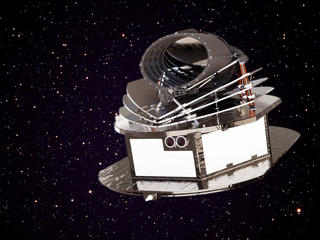Airbus has successfully passed the Preliminary Design Review (PDR) of Ariel, the Atmospheric Remote-sensing Infrared Exoplanet Large-survey spacecraft. This European Space Agency (ESA) mission will study the composition of exoplanets, how they formed and how they evolve, by surveying a diverse sample of about 1000 extrasolar planets in visible and infrared wavelengths.
Development and testing of equipment and sub-systems can now continue to ensure the spacecraft moves ahead on schedule under the lead of Airbus, prime contractor of this contract. Airbus will also provide expertise and support to ESA for the development of the payload module.
“Observations of these worlds will give us insights into the early stages of planetary and atmospheric formation, and their subsequent evolution. This will in turn contribute to the understanding of our own Solar System and could help us find out whether there is life elsewhere in our Universe and if there is another planet like Earth!” said Christophe Gabilan, Ariel project manager at Airbus.
More than 5,000 exoplanets have been identified since the first observation in 1995, notably by the ESA mission Gaia, also designed and built by Airbus. Another Airbus-built ESA mission, CHEOPS, launched in December 2019, is characterising exoplanets orbiting nearby stars, observing these known planets in the size range between Earth and Neptune and precisely measuring their radii to determine density and composition.
Yet little is known about the chemical composition of their atmospheres. The recent discovery by the Webb Telescope, notably thanks to the NIRSpec instrument, built by Airbus, of methane and carbon dioxide in the atmosphere of K2-18b, an exoplanet 8.6 times bigger than Earth, shows there is still a lot to uncover in the search for habitable environments.
After its launch, in 2029 on an Ariane 6 launcher, Ariel will be injected onto a direct transfer trajectory to the second Lagrangian point (L2). Thanks to its very stable thermal and mechanical design, the spacecraft will be able to carry out long term observations of the same planet/star system for a duration of between 10 hours and up to three days. Its mission will last four years with a possible extension of at least two years.

How does it work
Ariel will measure the emission of the star without the exoplanet to have a reference light spectrum in visible and near infrared frequencies. When the exoplanet transits in front of the star, the atmosphere of the exoplanet filters the light of the star. Comparing the light spectrum with and without the exoplanet atmosphere filtering impact, enables scientists to determine the composition of the atmosphere, in particular molecules with high interest such as water, carbon dioxide, methane, ammonia etc.
Fully dedicated to the study of exoplanets, Ariel will focus on warm planets, ranging from super-Earths to gas giants orbiting close to their parent stars, taking advantage of their well-mixed atmospheres to decipher their bulk composition.
Surveying the atmospheric composition of thousands of exoplanets and their evolution over several years will provide detailed data to the scientific community to elaborate and confirm models of exoplanets’ composition and evolution. Ariel’s observations will also lay the groundwork for future searches for life elsewhere in the Universe and planets similar to Earth[1] .
With design and technical specifications validated, around 40 suppliers from a dozen European countries are now on-board to deliver flight units, ground support equipment, and to support Airbus teams during the final design and manufacturing phase.
[1]From https://www.esa.int/Science_Exploration/Space_Science/Ariel_factsheet
Your media contacts
Contact us
Ralph Heinrich
AIRBUS | Defence and Space
Jeremy Close
AIRBUS | Defence and Space
Francisco Lechón
External Communications - Airbus Space Systems, Spain
Guilhem Boltz
AIRBUS | Defence and Space


